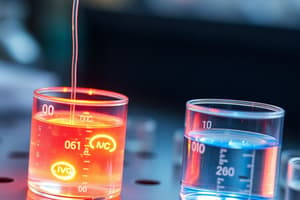Podcast
Questions and Answers
What is the purpose of an external power source in electrolysis?
What is the purpose of an external power source in electrolysis?
- To increase the boiling point of the electrolyte
- To provide the necessary electrical potential to drive chemical reactions (correct)
- To act as a physical barrier between the electrodes
- To create heat for the process
In terms of electrode potentials, what does a negative value indicate for a substance?
In terms of electrode potentials, what does a negative value indicate for a substance?
- Inert nature with respect to electron transfer
- Tendency to gain electrons and be reduced (correct)
- Tendency to lose electrons and be oxidized
- Neutral pH in the electrolyte solution
How does Kohlrausch's Law relate to the migration of ions in an electrolyte?
How does Kohlrausch's Law relate to the migration of ions in an electrolyte?
- The sum of ion migration coefficients remains constant regardless of individual ion concentrations (correct)
- Only the most abundant ion contributes significantly to electrical conductivity
- The speed of ion migration increases with higher concentrations of ions
- Ion migration coefficients change proportionally with ion concentrations
What role does the standard hydrogen electrode play in measuring electrode potentials?
What role does the standard hydrogen electrode play in measuring electrode potentials?
How does understanding redox reactions, galvanic cells, and electrode potentials contribute to modern technology?
How does understanding redox reactions, galvanic cells, and electrode potentials contribute to modern technology?
Flashcards are hidden until you start studying
Study Notes
Exploring Electrochemistry: Redox Reactions, Galvanic Cells, Electrolysis, and Electrode Potentials
Electrochemistry is a field that combines the principles of chemistry and electricity to study the interactions between substances in the presence of an electric current or voltage. At its core, electrochemistry focuses on redox reactions, galvanic cells, electrolysis, and electrode potentials, all of which are central to understanding the behavior of electrical energy and chemical reactions.
Redox Reactions
Redox reactions, short for reduction-oxidation reactions, are chemical reactions involving the transfer of electrons between substances. In a redox reaction, one substance loses electrons (oxidation), while another substance gains electrons (reduction). Redox reactions are crucial to electrochemistry because they form the basis of electrical energy generation and conversion in processes like galvanic cells and electrolysis.
Galvanic Cells
A galvanic cell is a device that generates electrical energy from a spontaneous redox reaction. It consists of two half-cells, each containing one of the reactants and a solid electrode. Electrolyte solutions bridge the two electrodes, and an external circuit allows the flow of electrons. The cell generates energy when the half-reactions occur spontaneously, releasing energy in the form of electrical current.
Electrolysis
Electrolysis is the process of using an electric current to break down water, or other ionic compounds, into their constituent elements. The electrolytic cell consists of two electrodes, an anode and a cathode, immersed in an electrolyte. An external power source provides the necessary electrical potential to drive the desired chemical reactions at the electrodes.
Electrode Potentials
Electrode potentials, also known as reduction potentials, represent the tendency of a substance to gain electrons and be reduced under specific conditions. Electrode potentials are measured in volts and are negative for reducing agents and positive for oxidizing agents. The standard hydrogen electrode serves as a reference point for measuring electrode potentials in standard conditions, and the Nernst equation describes the relationship between electrode potentials and reaction quotients under non-standard conditions.
Kohlrausch's Law
Kohlrausch's law, also known as the Kohlrausch's equation or the Kohlrausch's regula fidei, is a quantitative relationship between the coefficients of migration of ions in electrolysis. The law states that the sum of the coefficients of migration of ions in an electrolyte is constant, independent of the individual concentrations of the ions. Kohlrausch's law is a fundamental principle that helps explain the conduction of electricity in electrolytes and the distribution of current in electrolytic cells.
Understanding electrochemistry and its subtopics provides a foundation for exploring a wide range of applications, including energy storage and conversion, catalysis, corrosion, and environmental sciences. By delving into the intricacies of redox reactions, galvanic cells, electrolysis, and electrode potentials, one can gain a comprehensive understanding of the relationship between chemical reactions and electrical energy, ultimately leading to innovations in modern technology and scientific discovery.
Studying That Suits You
Use AI to generate personalized quizzes and flashcards to suit your learning preferences.




